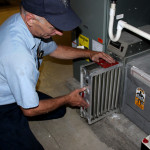Is It Time for a New Furnace Installation?
A new furnace installation is a major decision. Determining if an old unit should be repaired versus replaced can be decided when you consider the following factors:
- Do you have ever increasing utility bills related to your heating system?
- Is your furnace making strange noises?
- Are you having to constantly repair your current system?
- Is your household experiencing illness symptoms such as constant headaches, a burning feeling in nose or eyes, nausea, disorientation, flu-like symptoms? Aging furnaces can leak carbon monoxide caused by a failing heat exchanger inside your furnace.
Signs and Symptoms of a Failing Furnace:
Higher Utility Bills – As your furnace ages it can lose its efficiency. A lack of routine maintenance can cause higher heating bills when thermostats malfunction, filters are not replaced, or the system is not functioning optimally.
Repairs – Furnaces and air conditioners like all machines break down over time. Less efficient gas furnaces tend to breakdown more frequently in the last two years of their life. In addition, it may be hard to find replacement parts for older units. Depending on the life left in an old unit it may be a better alternative to use repair money towards a new, more efficient furnace.
Age – The average life expectancy of HVAC units in homes today can be between 16 and 20 years. Many people delay a new furnace installation due to costs but pay more for heat, air conditioning and electric as a consequence. The pilot light is a good indicator of age. If the pilot light is out in the open it is almost certain to be over 25 years old. Another way to determine the furnace age is to look for a model and serial number on your unit that you can verify with the manufacturer for the age of the system.
Carbon Monoxide – If your pilot on your furnace has a yellow or flickering flame it may be a sign that poisonous carbon monoxide could be present. If your furnace is emitting carbon monoxide it is important to address it immediately.
Some other possible signs to look out for are:
- Soot around your furnace
- Lack of upward draft in your chimney
- Excessive condensation on windows, walls, or other cold surfaces
- Rusty flue pipes
Strange Noises – Old furnaces can make some strange noises such as rattling, squealing, squeaking, banging, or popping noises. These should be investigated by a licensed professional to determine the proper repair required or if replacement is needed.
Options and Upgrades For Your Heating System
There are various types of furnaces on the market today. Each heating and cooling system is rated according to its level of efficiency. In addition to an efficiency upgrade there are several system options available including:
- Humidifiers
- Air cleaners
- Air purifiers
- Thermostats
- Zoning systems
- Dehumidifiers
Humidifiers – These add-ons are for the cool seasons in which you utilize your heating system. They add moisture to air which can remedy the dryness of most heating systems.
Air cleaners – Upgrade from standard air filter by installing an air cleaner. They are often recommended by physicians to people who have breathing issues. It helps to keep the air and the home cleaner providing better air quality and is installed directly in to the HVAC system.
Air purifiers – Different than an “air cleaner.”, air purifiers remove bacteria, mold, and various other pathogens in the home. This option is also installed directly in to the HVAC system.
Thermostats – Upgraded thermostats such as programmable thermostats help to gain energy savings for when heating or cooling is not needed. These thermostats will automatically turn down the temperature when premises is not occupied or during sleeping times. It allows the homeowner to choose the air temperature without constantly changing the thermostat. Wireless and wifi thermostats are also available to give homeowners the convenience of adjusting temperature remotely.
Zoning systems – These upgrades allow for total comfort control in a home. In this application there are multiple thermostats to control one heating system allowing for different temperatures in different areas/rooms of the home.
Dehumidifiers – This offers whole house dehumidification and works in conjunction with the air conditioning system. It is a good choice for musty or humid homes.
Other factors to consider when installing a new HVAC system in your home are:
Ducting – It’s important to have properly sized ducts. When searching for a new system it would be good to have existing ductwork inspected to ensure that it is compatible with the new system of your choice.
Chimney liners – Required on most new installations per city regulations (check with your city building department for specific requirements in your area), it lines the inside of the chimney to protect the brick structure from condensation and deterioration.
Condensate pumps – Optional item instead of using a drain line crossing the floor. Good option if you have a highly trafficked area.
Carbon monoxide detectors – Every piece of heating equipment produces CO but should be properly vented to the outside of the home. A CO detector helps to alarm occupants if there is a dangerous level of carbon monoxide in the home.
Free Estimate & Professional HVAC Advice
Our knowledgeable staff can help you decide what is best for your home and budget. Each house and family has its own needs and we assist our customers through the process of selecting the right system for their home. If you would like to have a new furnace installed at your home, we offer a free estimate on any furnace installation and can provide you with details on your current system, what would be required for a new install, and all of the options and pricing available to you.
For a Free estimate call us at 216 451-1355.
Comments or questions are welcome.


